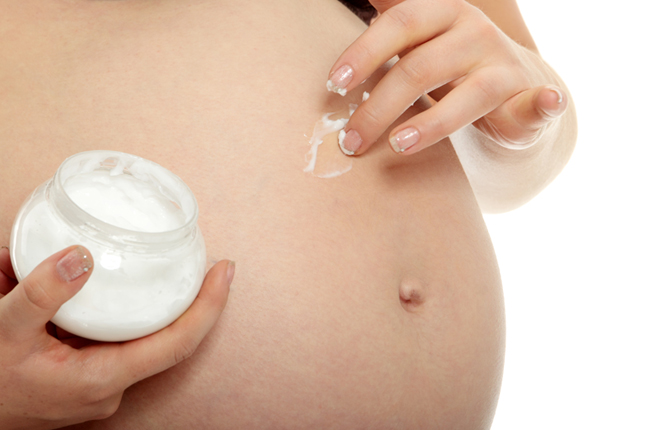Preggie Pals
Stretch Marks During Pregnancy
[00:00:00]
Please be advised, this transcription was performed from a company independent of New Mommy Media, LLC. As such, translation was required which may alter the accuracy of the transcription.
[Theme Music]
ANNIE LAIRD: With pregnancy comes a glowing, growing beautiful body. But sometimes pregnant women are prone to stretch marks. What are stretch marks and are they preventable? Once you have them, is there any way to get rid of them or at least reduce their appearance? Today, we’re talking with Kim Walls, an international recognized skin care expert on the 411 on stretch marks. This is Preggie Pals.
[Theme Music/ Intro]
ANNIE LAIRD: Welcome to Preggie Pals broadcasting from the Birth Education Centre of San Diego. Preggie Pals is your weekly online on-the-go support group for expecting parents and those hoping to become pregnant. I’m your host Annie Laird.
Thanks to all of our loyal listeners who have joined the Preggie Pals Club. Our members get special episodes, bonus content after each new show plus special giveaways and discounts. See our website for more information.
Another way for you to stay connected is by downloading our free Preggie Pals app available in the Android, iTunes and Windows Marketplaces. Now, Samantha our producer is now going to give us some more information about our Virtual Panellists Program.
SAMANTHA EKLUND: All right. Thanks Annie. So, if you don’t live in San Diego but you’d like to be a panellist on our show, you can still participate through our Virtual Panellists Program. Just like us on Facebook and follow us on Instagram using hash tag #preggiepals.
We’ll post questions throughout the week prior to our taping. We’d love for you to comment so we can incorporate your thoughts into our episode. You can also submit your questions directly to our experts. Learn more about our VP Program through the Community Section on our website www.PreggiePals.com.
ANNIE LAIRD: Thanks Samantha. All right, well let’s go around the studio and introduce ourselves. My name is Annie. I’m going to be 36 next week. I’m a government contractor. I don’t have a due date. I have three little girls at home. Two of them are hospital births and then the last was home birth.
STEPHANIE GLOVER: I’m Stephanie Glover. I’m a stay-at-home mom. I have two daughters ages 2 ½ and 9 months; both births were hospital births. The first was a C Section and the second a V Back.
SAMANTHA EKLUND: All right, I’m Samantha. I’m the producer here at Preggie Pals. I am 22 years old. I’m a stay-at-home mom for my 19-month old Olivia. I don’t currently have a due date although I wish that I did. I had an unplanned caesarean with Olivia and I’m hoping for a V Back next time around.
ANNIE LAIRD: But see your kid is mobile now. So, that’s good that you don’t have a due date right now.
SAMANTHA EKLUND: Right, a second; exactly – this exact second.
ANNIE LAIRD: I can tell you having 16 months apart is insane when you’re pregnant.
SAMANTHA EKLUND: It would go on the last on my mind.
SUNNY GAULT: Hey everyone. I’m Sunny. I’m the owner of New Mommy Media which produces – Preggie Pals, Parent Savers, The Boob Group and Twin Talks. I have four children under the age of four. I’ve got two boys and I have identical twin girls.
I’m all about this episode because after carrying around twins for 9 months or whatever, I have a few stretch marks that I did not have before. I made it through two pregnancies without stretch marks.
ANNIE LAIRD: No, really?
SUNNY GAULT: I did. I really did. Then, boy these little girls come along and then just rip me up. It’s actually really not that bad but I could always be better.
[Theme Music]
ANNIE LAIRD: We have a question for one of our experts. Jamie in Phoenix writes:
What is the difference between a child birth crash course that I can get in a one day course through my hospital versus one that I would go on town and spend several weeks. What extra things would be covered in the longer course? -Jamie
NIKKI HELMS: Hi Jamie. This is Nikki Helms and I am a postpartum mentor and child birth educator. I just want to say that: “Taking the crash course at the weekend one day child birth course is great. You’ll cover all of the topics but you won’t be able to cover them as in-depth as you would in a longer course.”
Also, a longer series course may give you the opportunity to make new mommy friends and bond with new parent families. It will give you an opportunity to meet new people exactly where you are. You meet new people that you are all having the same thing in common.
So given the option, I’m recommending the longer course; however, some people just don’t have time for it. Some of you can give him a crash course by all means, take it but please take your childbirth education course. So, get educated. Thanks Jamie. Have a great day.
[Theme Music]
ANNIE LAIRD: Today on Preggie Pals, we’re talking all about stretch marks. Joining us on the phone today is Kim Walls. She’s an internationally recognized skin-care expert focused on skin health and beauty for babies and moms. Welcome to Preggie Pals Kim. Thanks for joining us on the phone today.
KIM WALLS: You are most welcome Annie. Thank you and thank you for creating such a fantastic resource for pregnant women.
ANNIE LAIRD: So, what are stretch marks?
KIM WALLS: Stretch marks are tiny tears in the skin.
ANNIE LAIRD: Okay.
KIM WALLS: So, the skin is stretching, when the belly is growing rapidly sometimes the skin just can’t keep up. So, it’s a little rigid where there’s collagen breakdown between them. They are really just tiny tears, tiny little scars.
ANNIE LAIRD: So, you in the panellists, did either of you get stretch marks? You mentioned that before the episode, the look says it all.
SAMANTHA EKLUND: Yes, that’s it.
ANNIE LAIRD: So, that Samantha our producer was giving me the dear and the highlights look.
SAMANTHA EKLUND: It was me. I’m fortunate enough than I don’t have really severe ones. I’ve seen ones that are very red or very deep purple which luckily they were red when I was pregnant. Afterwards, they have faded like to white but they are definitely there.
ANNIE LAIRD: Where do you have them? Where did you get them?
SAMANTHA EKLUND: I’m going to say: “There are not many higher than my bellybutton so they are all below my bellybutton. But they are all across and then I have some like back on my hips.
ANNIE LAIRD: Yes, that’s where I got mine too. Stephanie, did you get any or no?
STEPHANIE GLOVER: Minimally.
ANNIE LAIRD: Yes.
STEPHANIE GLOVER: I agree too. I didn’t really ever look under my belly. So, I had thought I had: “I’ve got a pretty good belly for being pregnant.”
ANNIE LAIRD: Do you think like you have tiger stripes all the way down from the rib cage?
STEPHANIE GLOVER: Almost kind of a watermelon you know like that effect.
ANNIE LAIRD: Yes.
STEPHANIE GLOVER: but I actually noticed some more after birth kind of when I was shrinking back down. Then, I notice some maybe a little bit under my bellybutton as well.
ANNIE LAIRD: Yes, it used to be a really common area for them.
STEPHANIE GLOVER: I didn’t realize that. So, but I never noticed someone they were red, they’ve always just been that faded.
SAMANTHA EKLUND: Right.
STEPHANIE GLOVER: And fuller.
KIM WALLS: It’s actually possible that they weren’t there when you’re pregnant. Sometimes the stretch marks appear after the pregnancy.
ANNIE LAIRD: Really? Like in postpartum?
KIM WALLS: Yes, exactly.
ANNIE LAIRD: That could have been it.
KIM WALLS: Exactly.
ANNIE LAIRD: What does stretch marks look like? It seems like just with the women in our studio, they have a different experience with different colour.
KIM WALLS: Welcome to the world of skin. People call “dermatology witch craft” because the skin is this magical organ. It changes and it’s different for everybody and the tones are different. Different kinds of things respond to be exact same circumstances differently.
You guys actually a great job of describing the various ways that stretch marks present themselves. They can be deep, deep purple. They can actually have rigid that you can feel as you brush your fingers over them. They can be a little white jagged line. They really can take many, many forms.
But what is consistent about stretch marks related to pregnancy is: “They do usually appear on the tummy, breast, hips and thighs.” Breast is where I got mine.
ANNIE LAIRD: That was going to be my next question here was: “Where are they found on the body?” It just seems like here in the studio with our little small sample size of three. It seems to be lower belly seems to be pretty consistent place. Yes, as you were saying: “They can be found in other places on the body as well.”
KIM WALLS: Yes, anywhere that skin has stretched in. If you think about: “How our bodies are designed to work? Of course, the breasts grows. The hips grow. The thighs were storing a little bit of extra fat can make sure that as babies were thriving and all of those areas have to grow.” Those skin areas have to grow to accommodate those extra nutrients that we’re holding onto you. To make sure they can keep our babies healthy.
ANNIE LAIRD: Do all pregnant women get stretch marks? Some like magical women out there that don’t get stretch marks?
SAMANTHA EKLUND: It must be nice.
ANNIE LAIRD: Exactly.
KIM WALLS: Yes and there were very rare. Most women do get stretch marks and those who don’t are rare.
ANNIE LAIRD: I hated it; just kidding Preggie Pals. If you don’t get any stretch marks, we still love you once you listen to our podcasts.
KIM WALLS: Yes. It’s about 90% of women who will get them. It doesn’t mean they’ll all keep them. But during the pregnancy and shortly thereafter, almost everybody can share this concern and [inaudible] together.
ANNIE LAIRD: I have no idea that it was common. I guess I only have a few but I guess that the pictures that I’ve seen when you type in Google: “Stretch marks and pregnant woman.” That’s a good way to make you feel better about yourself maybe. But, that’s I guess what I thought it was like: “All over the belly and on the upper arms and thighs and everywhere and I only have a few compared to that.” Is there something that makes a woman more prone or less prone to getting stretch marks?
KIM WALLS: Yes, absolutely something unfortunately that we don’t have much control over which is our genes. Generally, if your mother had stretch marks, you have a higher likelihood of also getting them. But, there are other factors, our hormone levels in the body, the skin care we use; there are all kinds of things that make women more or less likely to get stretch marks.
But for those who are more likely by taking proper care, it is possible to minimize them and potentially not have them at all. But certainly would minimize them and even eliminate them throughout after the birth.
ANNIE LAIRD: Sunny’s here in the studio. So, I know you have something probably to ask about like twin pregnancies.
SUNNY GAULT: Yes like I’ve said before: “I really didn’t get anything with my first two and then after I had my twins and I didn’t even go the full gestation with my twins. I gave birth at about 35 weeks.” But I was still bigger than I was with either with my singleton pregnancies. What I ended up getting; it almost looks like around my naval, it almost looks like a little sunburst.
SAMANTHA EKLUND: A free tattoo.
SUNNY GAULT: A great tattoo and my name is Sunny. I don’t really know. The skin honestly is pretty lose right there, right now at least. I’m 6 ½ almost 7 months postpartum and I’m still working on that area.
ANNIE LAIRD: I think it’s a part with the three – of third pregnancy. I didn’t have twins for my third pregnancy
SUNNY GAULT: Maybe
ANNIE LAIRD: I’m having a heck of a time losing and the stretch marks are definitely more noticeable I think with just so the pregnancy. Maybe I gain and eat too much ice cream.
SUNNY GAULT: I do have stretch marks on breasts too. Do you guys get that?
SAMANTHA EKLUND: I have a few and I give it a look.
ANNIE LAIRD: Everybody on the studio, look at your boobs.
STEPHANIE GLOVER: I have a few. I think you should put the camera away.
SAMANTHA EKLUND: I have a few from breastfeeding from getting engorged.
SUNNY GAULT: Engorged, yes. I did have that from the other babies. Yes, that has nothing to do with the twins. It really wasn’t bad and mine are not red. They’re just like little lighter.
ANNIE LAIRD: Just white, yes.
SUNNY GAULT: But it really does drive me crazy because as woman, I think we’re just so prone to looking at our abdominal area. We’re just so obsessed with getting the weight off and that’s one area I always look at first. First, it’s like the place in my body that the weight is lost last there; if that makes any sense.
ANNIE LAIRD: That’s where I am right now. I’m seven months postpartum but the stretch marks are just still there.
SUNNY GAULT: I know. I don’t know what to do about it and like I’ve said: “The skin is loser there too.” I may just need some surgery. I really have to talk to my husband about that.
ANNIE LAIRD: Well, when we come back, we’re going to be discussing: “How to prevent stretch marks or if you can’t prevent them, at least to minimize the look on your body.” We’ll be right back.
[Theme Music]
ANNIEL LAIRD: Welcome back. Today, we’re discussing stretch marks. Kim Walls is our expert. Now Kim, do stretch marks that ever go away once you get them?
KIM WALLS: They do usually. Usually, they do. They almost always get minimized. But yes and you don’t even have to wait that long actually. After pregnancy, most often the majority of stretch marks will go away within 6 to 12 months after pregnancy. There’s hope.
ANNIE LAIRD: I’ve got a few more months to go here. Is there anything that they could do if they don’t go away? There’s a woman listening to this podcast and their baby is two years old and they still have stretch marks. What can women do to reduce the appearance of the stretch marks when she’s had them and it’s looking like they’re not going anywhere?
KIM WALLS: It’s a great question. There is definitely more to you when it comes to prevention which will get to. But when it comes to getting rid of them once you’ve had them, just keep in mind that they are tiny tears. They are little scars. So, the same kinds of things that you would do for scar treatment, you would do for stretch marks.
One of the things is a massage; to massage your skin constantly. Just like after a surgery or anybody who wants to get rid of the scar, most medical professionals will say: “Give it a little massage. A few minutes in there, just pay attention to it. Give it some love.”
They are ingredients in skin care that can certainly help with stretch marks. Most of those would be in of it was really work would be way too aggressive for anybody who’s breastfeeding. Yes, you’ve mentioned earlier in the call – maybe a little not too much surgery but in the cases of stretch marks, there are laser treatments that can help.
Post pregnancy, there are really a lot of ways to get rid of them. But the key is prevention.
ANNIE LAIRD: What are some of the ingredients? Obviously, there are some creams, oils and salves and that type of supplement. But, what is in those products that a woman can – what about them actually prevents the stretch marks in the first place?
KIM WALLS: Prevention or treatment?
ANNIE LAIRD: Well, how about both? What are the ingredients for prevention and reduction? Are they the same or they are different things in those products?
KIM WALLS: No, they’re different, completely different.
ANNIE LAIRD: Okay.
KIM WALLS: So, there are kinds of things that we were talking about earlier where you’re really working to get rid of the stretch marks that you already had. Definitely, you get into things like high levels of Vitamin A which creates other problems. You don’t want to expose skin to the sun.
If it’s got Vitamin A high levels on it, there are things like Burberry extract that essentially act as bleaches to the skin. That happens to be a natural version of them. There are others like Hydroquinone which can also do that job. There are ingredients that go beyond the benefits of helping with stretch marks all the way over to helping make sure your baby thrives when your baby is born.
As soon as you have that pro-biotic or that healthy bacteria on your skin, that gets transferred over to baby. So, once baby is born, they pretty much there. They are no such area on your skin. But within that first 48 hours of birth, baby can completely populated and they need that. They absolutely need that healthy bacteria to thrive and the best place for them to get it is from mom. It happened during skin-to-skin time.
So, if you’re using pro-biotics during pregnancy to help prevent stretch marks and help care for stretch marks, you’re also adding in that benefit of making your own eco system thrive so that you can give that to your baby when they’re born.
When it comes to making sure you prevent them, the kinds of ingredients; it’s actually less important than the time you use your skin care products and the approach you use to skin care. So when it comes to stretch marks, you want to keep the skin hydrated. Keep it highly moisturized.
One of the big misconceptions around moisturizing skin is that: “If you put heavy duty oils on that you’re moisturized on your skin.” That’s exactly wrong. What actually happens is that: “It will insulate the skin. It will prevent the loss of moisture.” But if the skin is dehydrated, those oils won’t help put the moisture back in.
Just like any other time – if you’re dehydrated, your body is not going to work properly whether you’re dehydrated from alcohol; not when you’re pregnant. Of course or to be dehydrated from an exercise; all of these dehydration conditions cause all kinds of problems. The skin is no different.
If the skin is dehydrated it won’t be able to:
• Build cells quickly
• Repair cells quickly
• Be responsive to the conditions of pregnancy and growing skin
So, you want to hydrate? There’s moisturizing ingredients; things like Aloe Vera. Organic in particular is of course great when you’re pregnant; it’s such an option – purified organic aloe, no fragrances, and no dyes.
Lotions and moisturizers that contain high water content ingredients are really helpful to hydrate the skin. Then do a second layer that keeps that moisture in the skin. So, that’s where you get in the heavy oil; not petroleum which is not healthy for skin. Not beauty products that oils that are natural and healthy and have high levels of essential fatty acids building blocks for skin.
So, keep it moist and then use the oil to massage and to keep the moisture in. Then, after a bath, within 3 minutes apply those oils.
ANNIE LAIRD: Yes, I was going to ask. That’s always what I’ve kind of heard is that: “Once you’ve get out of the water, that’s the great time to moisturize right then.”
KIM WALLS: Absolutely and that’s when you use your heavy oil products. Not even massaging and the things that will keep the water in and you’ve got about a three-minute window before the skin really starts to dry out and lose all that good extra water.
ANNIE LAIRD: Are there any old wives tales that you’ve heard just from being a skin care expert? I’m sure that this is what you do day-in and day-out.
KIM WALLS: There are wives tales about Vitamin E doing great for stretch marks in particular which is no proof there. There are certain products out there that it’s better around forever that talk about: “Having specific formula that is specifically design to eliminate stretch marks.”
There’s no special magic bullet. It’s about the right kinds of healthy ingredients and the right use and approach. But try a new one. Do you want to hear sort of newer information about stretch marks in pregnancy is that: “It’s something to keep in mind about the condition of the skin and what keeps it healthy; things that keeps the skin healthier are also going with the help prevent minimize and reverse stretch mark.”
We have a thriving eco system on the skin. There’s every square inch of the skin cells, you’ve have the actually have the more bacterial cells, healthy, important bacterial cells than you do skin cells. Keeping that environment thriving, healthy and happy that eco system flourishing is one of the most viable and important things that you can do for your skin and that includes especially during pregnancy.
ANNIE LAIRD: Okay. Does the appearance change over time?
KIM WALLS: Certainly. They do. The appearance of stretch marks change pretty dramatically within short periods of time. So, you can have big, deep purple stretch marks and then six months later have been faded all to white; absolutely, yes.
SUNNY GAULT: What causes that? Do you know Kim? I’m just curious if someone has a stretch mark and it starts out all purply, I would imagine that have something to do with blood or something in the body and then how it goes to like a whitish colour?
SAMANTHA EKLUND: To just healing perhaps?
SUNNY GAULT: I don’t know.
KIM WALLS: It’s about balance. It’s about being out of luck. Any time there is a colour in the skin that’s related to the Melanocytes producing melanin. So, our skin is dependent upon the Melanocytes – it’s a specific kind of cell which produces melanin which causes the colour of the skin.
So, if there’s a little scar and the Melanocytes aren’t functioning properly then the skin will be more pail and more white. So, it’s really the paling of scars is really just a reflection of skin cells that shouldn’t be there and functioning that really aren’t. It’s also why scars and these little tears are more susceptible to sun damage because the melanin is protecting our skin from damage.
ANNIE LAIRD: I wonder does the same thing apply to – so I had a C Section with my daughter. I mean from having major surgery, I do have a pretty significant scar that’s definitely faded over the past almost 20 months but it’s still noticeable. Do these principles apply to a C Section scar like they would stretch marks or there’s that need like say more aggressive treatment.
KIM WALLS: It’s the same thing. It’s fundamentally the same thing. We treated them the same way. You can use the same kinds of ingredients. If the skin care doesn’t work then you can go to lasers and get more and more technical in the medical community until you’re able to have that – be happy with your body and feel good about it.
ANNIE LAIRD: What is a like you mentioned Vitamin A products. What is Retin A? I guess Retin A would be like the product name. But, what like a high Vitamin A what does that do that actually helps with the appearance of stretch marks? How does that work?
KIM WALLS: Well, it accelerates the turnover of skin cells. It’s very important here to throw in a caveat that: “Vitamin A and especially high levels of Vitamin A is a highly controversial topic.” Certainly, inappropriate for pregnancy – don’t make no mistake there. Do not use Vitamin A while pregnant or nursing or anything else.
ANNIE LAIRD: Yes, I was going to say because I used that product like for acne. I remember that when I got that prescription obviously have to get that through a dermatologist, that there was a big: “Okay, you’re not pregnant. I have to take a pregnancy test to make sure I wasn’t pregnant.” I got bad effects on baby like fetal development.
KIM WALLS: So, topically what is does is really: “It accelerates the turnover of skin cells.” So, you can have all kinds of – if your old skin cells let’s laughing off and new skin cells replace those. New skin cells tended to be healthier, more vibrant, and scar-free. So, as you accelerate the turnover of the old skin cells and create present in new skin cells; that skin is likely to be more smooth. So, that’s basically how it works.
ANNIE LAIRD: How does a laser treatment work? Is that kind of a same thing?
KIM WALLS: No, there are all kinds of different laser treatments. But fundamentally, probably the most common for stretch marks would be a “resurfacing tactic.” It’s the same basic idea. Get rid of the old skin cells. Bring some new skin cells in.
So, laser is a much more aggressive way to do that; where you can take of the top one or top many layers of skin cells to the point where somebody is really bloody and pulpy. If I was getting infections, there are all kinds of challenges around that. But, it takes the old skin cells and you get the new ones back.
ANNIE LAIRD: Is that something that you would have to go through a doctor to get done like a laser treatment or is that something like a skin care person would be able to do?
KIM WALLS: There are places like medi spas that do those. Generally, it depends on how aggressive of a laser treatment and what types of lasers are used. Definitely, I think it’s good to have a doctor who is overseeing these kinds of things. There are cases that where it goes wrong. So, you want somebody who really knows what they’re doing and not something you want to run off to in other country and do because it’s cheaper.
ANNIE LAIRD: Yes. Is that something with laser treatment – if someone was interested in that, is that something like a one-time shot or do they have to keep going back and getting that done?
KIM WALLS: Well again, it depends on the types of lasers and the types of treatments. There are both versions of that. But generally, it would be a multi-step process probably to fix treatment.
ANNIE LAIRD: Okay, what’s that cost usually associated with something like that?
KIM WALLS: It varies fairly dramatically. It can be lots of hundreds of dollars and it can be lots of thousands of dollars.
ANNIE LAIRD: I didn’t realize that it was so expensive.
KIM WALLS: It can be.
ANNIE LAIRD: I can’t imagine my insurance covering that because it pretty probably would be of like a medical associate would be like: “Yes just go massage your scar tissues for free.” Free thirty.
KIM WALLS: There’s of course that element of: “This is who we are. These are our battle wounds. These are reminders that there are incredible lives that we brought into this world.” There’s certainly the approach of: “Embrace it, love it, because it is your body. You’ve only got one.”
ANNIE LAIRD: Thanks Kim for joining us today. For more information about Kim as well as information about any of our panellists, visit the episode page on our website. This conversation continues for members of our Preggie Pals Club.
After the show, Kim is going to be talking with us about: “Stretch mark products and how you can use them if you’re breastfeeding your baby and if it’s safe for your baby.” To join our club, visit our website www.preggiepals.com.
[Theme Music]
ROBIN KAPLAN: Hi Preggie Pal listeners. I’m Robin Kaplan an International Board Certified Lactation Consultant, owner of The San Diego Breastfeeding Centre and the host and producer of Preggie Pal’s sister show The Boob Group.
I’m here to offer some advice on what you can do during pregnancy to prepare for a positive breastfeeding experience such as: “Think about setting your breastfeeding goal with your partner.” Breastfeeding is only one component of parenting where you will want to be on the same page with your partner.
While The American Academy of Paediatrics recommends exclusive breastfeeding for the first six months of your baby’s life until one year with complimentary foods and then past one year as long as it’s neutrally beneficial for mom and baby – this may not be your personal breastfeeding goal.
Everyone in your life will have an opinion about how long you should breastfeed. However, it is up to you and your partner to figure out: “What makes the most sense for your family.” Now, why is this important to decide while you were still pregnant? Well, there are many reasons.
Say you were having a breastfeeding challenge when your baby is a few weeks old, if you and your partner have set your breastfeeding goal for a year, it will definitely make sense for you to seek the help you need at this early stage of your goal. It’s like investing in the perfect shoe as you’re trained for a marathon.
What if you have a critical family member who is making passive, aggressive comments about how often your baby breastfeeds and wonders aloud: “Why you just don’t give your baby a bottle so you can sleep more?”
If you have set your breastfeeding goal with your partner, all he/she has to do is: “Take this person aside and let him/her know that you both would appreciate only breastfeeding positive comments in your presence.”
Lastly, once your family reaches your initial breastfeeding goal, you all have something to celebrate together. Plus, you may just decide to extend that goal a little bit further if things were going really well for all of you.
For more great information about: “What you can do during pregnancy to prepare for a positive breastfeeding experience, please check out my blog at the www.sandiegobreastfeedingcentre.com/blog . Be sure to listen to listen to Preggie Pals and The Boob Group for fantastic conversations about breastfeeding and breastfeeding support.
[Theme Music]
ANNIE LAIRD: That wraps up our show for today. We appreciate you listening to Preggie Pals.
Don’t forget to check out our sister shows
• Parent Savers for parents with new born, infants and toddlers
• Twin Talks for parents of multiples
• Our show The Boob Group for moms who breastfeed their babies
Next week, we’ll be discussing: “Being pregnant in the military.” This is Preggie Pals: “Your pregnancy, your way.”
[Disclaimer]
This has been a New Mommy Media production. Information and material contained in this episode are presented for educational purposes only. Statements and opinions expressed in this episode are not necessarily those of New Mommy Media and should not be considered facts. Though information in which areas are related to be accurate, it is not intended to replace or substitute for professional, Medical or advisor care and should not be used for diagnosing or treating health care problem or disease or prescribing any medications. If you have questions or concerns regarding your physical or mental health or the health of your baby, please seek assistance from a qualified health care provider.
SUNNY GAULT: New Mommy Media is expanding our line up of shows for new and expecting parents. If you have an idea for a new series or if you’re a business or organization interested in joining our network of shows through a co-branded podcast, visit www.NewMommyMedia.com .
[00:28:51]
[End of Audio]












